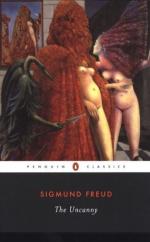
|
| Name: _________________________ | Period: ___________________ |
This test consists of 15 multiple choice questions and 5 short answer questions.
Multiple Choice Questions
1. What does Freud argue happens to the child in the first stage of the developmental process?
(a) The child begins to grow territorial.
(b) The child loves everyone.
(c) The child feels that others are taking his or her parents away from them.
(d) The child questions everything.
2. What culture believes a vulture is a symbol of one's mother?
(a) French.
(b) Egyptian.
(c) American.
(d) Italian.
3. What happens in the second stage of a child's developmental process, according to Freud?
(a) The child may fantasize that he or she was adopted.
(b) The child loves no one.
(c) The child may begin to hate his or her parents.
(d) The child begins to question his or her parents.
4. What are men searching for when the admire women with long feet?
(a) The female penis.
(b) The female privates.
(c) The male's privates.
(d) The male's penis.
5. What animal opens up Da Vinci's mouth in his memory from when he was a baby?
(a) A crane.
(b) A rooster.
(c) A vulture.
(d) A pelican.
6. What does Freud call the third stage of a child's developmental process?
(a) Family neurtoics.
(b) Family romance of the neurotics.
(c) Romance neurosis.
(d) Neurosis of the family.
7. What does Freud feel Da Vinci's bizarre childhood memory really is?
(a) An uncanny.
(b) A projection.
(c) A screen memory.
(d) A hidden desire.
8. What happens to a child's perception of their parents as a child grows mentally?
(a) Nothing.
(b) They grow appreciative.
(c) They begin to detest and resent their parents.
(d) They learn the ugly truth about their parents.
9. What does Freud argue the appearance of an emperor or empress means in one's dream?
(a) A representatio of the dreamer's parents.
(b) Their desire for authority.
(c) Nothing.
(d) Their need for order and rule.
10. Who was exiled from his family as a child?
(a) Oedipus.
(b) Thebes.
(c) Oedipus's mom.
(d) Sophecles.
11. How did Da Vinci perceive romantic love?
(a) Too idealized.
(b) With disgust.
(c) With hope.
(d) With regret.
12. What did Da Vinci avoid eating?
(a) Animals.
(b) Rice.
(c) Lettuce.
(d) Bread.
13. Who kills his father and marries his mother?
(a) Thebes.
(b) Sophecles.
(c) Oedipus.
(d) Oedipus's mom.
14. What does a tail symbolize in many cultures, like Italian?
(a) A male's control.
(b) A male's desire.
(c) A male's thoughts.
(d) A male penis.
15. What smacks baby Da Vinci on the lips in his childhood memory?
(a) The rooster's tail.
(b) The vulture's hand.
(c) The vulture's tail.
(d) The crane's tail.
Short Answer Questions
1. What does Freud focus on in the essay "Family Romances"?
2. Who did Da Vinci have a strong identification with, like most homosexuals according to Freud?
3. How does the child view his parents, according to Freud?
4. How do children tend to think of their mother, according to Freud?
5. What does Freud intend to do by looking at Da Vinci?
|
This section contains 507 words (approx. 2 pages at 300 words per page) |

|




